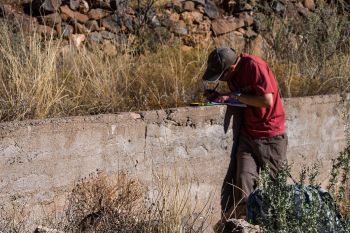Owner Inspection

|
| Inspecting Fossil Creek Dam.
(Image Source: Wikimedia) |
Dam owners play a crucial role in ensuring the safety and efficiency of all dams under their jurisdiction. Inspections are crucial to monitor the condition of the dam, identify potential risks or issues, and implement necessary maintenance and repair measures.
Dam owner inspections involve a combination of visual assessments, data analysis, and documentation. The specific requirements and protocols for inspections may vary depending on regulatory guidelines and the dam’s size. Generally, dam owners rely on qualified engineers and dam safety professionals to carry out these inspections.
Visual inspections form a significant part of dam owner inspections. Various components of the dam, including the structure, spillways, gates, embankments, foundations, and instrumentation need to be inspected. The dam must be assessed for signs of distress such as cracks, erosion, leakage, seepage, settlements, vegetation patterns, or any other indicators of potential issues. Downstream areas must also be inspected to identify any impacts or changes caused by the dam's operation.
In addition to visual inspections, dam owners must analyze monitoring data and maintenance records to assess the performance and integrity of the dam. Often, this process includes reviewing water level gauges, seepage monitoring devices, or vibration sensors, if applicable. Dam owners also review maintenance and repair records to ensure that routine maintenance tasks are being carried out on schedule and that any necessary repairs have been addressed promptly.
Based on the inspection findings, dam owners generate comprehensive reports that outline the condition of the dam, observations made during the inspection, and recommendations for any necessary actions. The recommendations may range from routine maintenance tasks, such as vegetation management or gate lubrication, to more significant repairs, such as crack repairs or embankment stabilization. Reports guide the dam owner in prioritizing actions and making repairs is necessary.
Apart from routine inspections, seismic events, extreme weather conditions, changes in upstream or downstream conditions, or alterations in the dam's operating parameters may require special inspections to assess any potential impacts on the dam's stability or functionality.
Dam owner inspections play a vital role in ensuring the safety, reliability, and compliance of dams. By proactively monitoring and assessing their dams, owners can identify issues in a timely manner and implement necessary maintenance and repairs. This helps to prevent the escalation of problems, minimizes potential risks, and ensures the long-term functionality of the dam, protecting public safety and valuable water resources.
Best Practices Resources
![]() Safety of Dams: Policy and Procedures (ER 1110-2-1156), USACE
Safety of Dams: Policy and Procedures (ER 1110-2-1156), USACE
